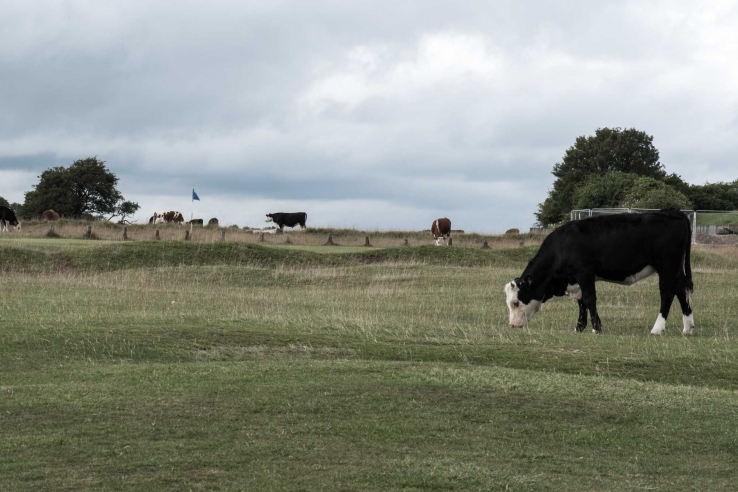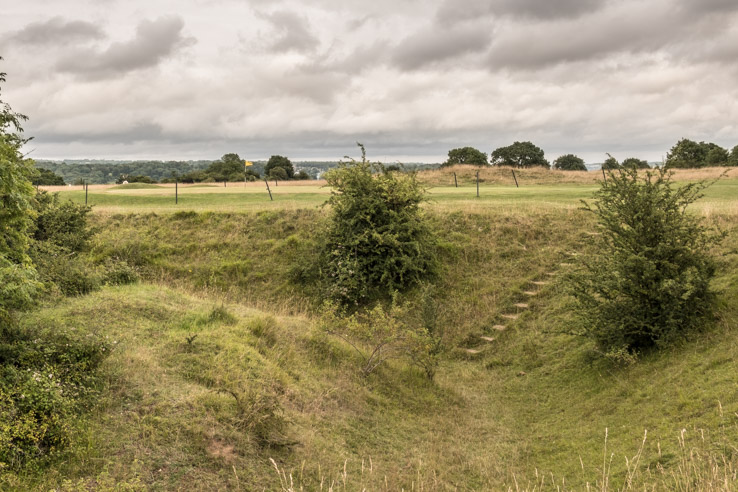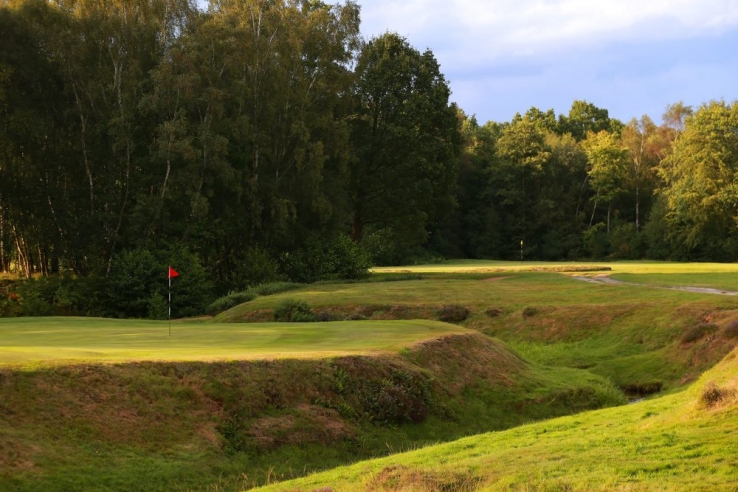Bunkerless golf courses * capture the attention of keen golf course architecture enthusiasts. Perhaps it is the irony of great golf without a design element considered to be integral to both golf course design and strategy. Nowhere are they better presented than in England.
* As a caveat, in early golf writing bunkers were often qualified by adjectives. For example, cop-bunkers, sand bunkers or grassed bunkers. Through the passage of time, bunkers have become synonymous with sand-filled hollows of various descriptions.
Bunkerless Golf Courses in England
England is in a league of its own when it comes to great examples of such designs. Amongst them are Berkhamsted Golf Club, Kington Golf Club, Minchinhampton Golf Club, Piltdown Golf Club, Painswick Golf Club, Welshpool Golf Club, West Manmouthsire & Royal Ashdown Forest Golf Club.
Common Land & Golf
A significant factor between most of these courses is they are found on common ground. For those not familiar with this term, common land in England is ground over which other people have certain rights. Of interest, these permissions have created a symbiotic relationship with the land, its usage and the golf course architecture.
Pasturage
The most widespread right for commoners is pasturage, allowing persons to pasture cattle, horses, sheep, lamas and other livestock. Today at Minchinhampton Old, you need to play through all manner of livestock as seen in the photo below. Local rules are in place to deal with hoof marks and other 'material concerns' associated with the beasts.

Estover
Other rights afforded to commoners have affected not only the pursuit of golf but also golf course design. For example, estover rights allow commoners to take wood and use it for making implements, fences and firewood. Tree management was integral to the use of the land, albeit for survival rather than the pursuit of a sport. With the exception of Berkhamsted and Royal Ashdown Forest, the other courses mentioned are not fettered with trees and the subsequent frustrations that result.
Common in the Soil
Another example is that of 'Common in the Soil'. This right allowed commoners to extract sand, gravel, marl, stones, lime and other minerals. The remaining quarries and pits have been used to good effect as hazards and green sites as seen in the photo below of Minchinhampton Old. In fact, Hebert Fowler and James Braid used these manmade features in their design at Yelverton Golf Club.

Planning Restrictions & Bunkerless Golf Courses
Royal Ashdown Forest Golf Club is bunkerless not because it is common land but because the Ashdown Forest is protected from any alterations made by man. The course needed to be built without any need or reliance on artificiality, bunkers included. What could have been considered a restraint worked in the club's favour as the course needed to make use of what nature offered? In this case, its weakness has become its strength.

Maintenance & Bunkerless Golf Courses
Piltdown Golf Club was designed and built with sand bunkers. During WW1, maintenance budgets and manpower were limited so the bunkers were allowed to go to grass and replaced with heather banks. Since then, with reduced maintenance costs, no one seems to have missed them...

Bunkerless Golf Courses & Architecture
The aforementioned golf courses exist in this form for a variety of reasons. What is for certain is most individuals playing them would not even notice they are missing one of golf's most beloved hallmarks unless it was pointed out. That begs the questions: Are bunkers really needed? Is it a design element that is overlooked?
Bunkers - Are they even needed?
The answer to the question is 'No', as is proven by the six courses previously mentioned. It is, however, an entirely different question to ask if the courses would be improved if they did have bunkers. Golf in its simplest form requires a ball, stick and hole. In the modern age, teeing grounds, putting greens and fairways would be considered essential, if not elementary. It must be said though that for golf to be truly engaging, topography or ground contours assist greatly.
Golden Age Golf Course Architecture Principles
Alister MacKenzie's 7th principle of golf course architecture states: 'The course should have beautiful surroundings, and all the artificial features should have so natural an appearance that a stranger is unable to distinguish them from nature itself.' It is interesting that bunkers themselves mimicking seaside dunes have become 'naturalised' elements of inland golf. I guess this is exactly what Alister was alluding to. When introduced, artificial features should 'look' natural. Reading between the lines, he wasn't saying that artificial features don't have a place but should appear as though they do and have occurred naturally.
Is necessity the mother of invention?
When you can rely upon exciting topography, epic views and have the equipment and budget to literally make and move mountains, the tendency could easily be to simply do so. Perhaps being handcuffed by not being able to add bunkers makes the architect work harder to make the most of what he has. When restrictions are imposed, the metal of the architect is really put to the test. When you can hide behind smoke and mirrors, it would take a motivated individual to still create the current iteration even if bunkers would have been in his or her arsenal.
Perhaps this is why each of these bunkerless golf courses stands out amongst its peers. Kington Golf Club is one of the best golf courses in England. Minchinhampton Old provides outstanding value for money and would be shown more love if it the average golfer wasn't caught up with the green speed and cross-hatch mowing lines. Painswick Golf Club is just one of 18 golf courses in all of the UK & Ireland which made Tom Doak's Gourmet Choice. The remaining could equally be given the same plaudits.
Bunkerless Golf Courses Summary
When you consider the benefits of bunkerless golf courses, does it seem logical that we will see more of them? One would think so! They're unique, different and exciting. They offer a potential reduction in maintenance costs - depending on what is used in place of them. There is of course no perfect solution as any element of a golf course needs to be maintained. Grassed hollows present a unique challenge and, depending on the local circumstances, a lot of variety in construction and design.
Just as exciting is the prospect of seeing more above-ground features. Brian Schneider and Blake Conant have done exactly that at Llanerch CC in PA, USA. Reminiscent of the above-ground features found at Walton Heath, could this be the watershed moment for fewer bunkers and more above-ground features? Cyclical, some of golf's most iconic designs include these features, such as the Dell and Klondyke at Lahinch. If it worked then and have stood the test of time, the principles therein must provide the basis for design moving forward.
In addition, those who move the needle with regards to golf course design have successfully pulled it off. The popular Bill Coore and Ben Crenshaw design at Bandon Dunes known as the Sheep Ranch has received rave reviews. Make no mistake, when those at the forefront of the industry create a wake, it allows the rest to follow behind. A case and point approach calms the nerves of most more than investing in being the first to break new ground.
We will have to wait and see, but for some courses, fewer bunkers may be a fine solution. In any event, this just may be the genesis of a movement in golf course design and architecture. The famed golf course architect, Robert Hunter wrote when surveying JF Abercromby's Addington, 'These undulations indicate the possibility of having one day a golf course so moulded that sand bunkers may be dispensed with.' Maybe that day has now come?
Further Reading on Bunkerless Golf Courses
A very interesting read is Ian Andrew's 'A Complete Look at Bunkering'

